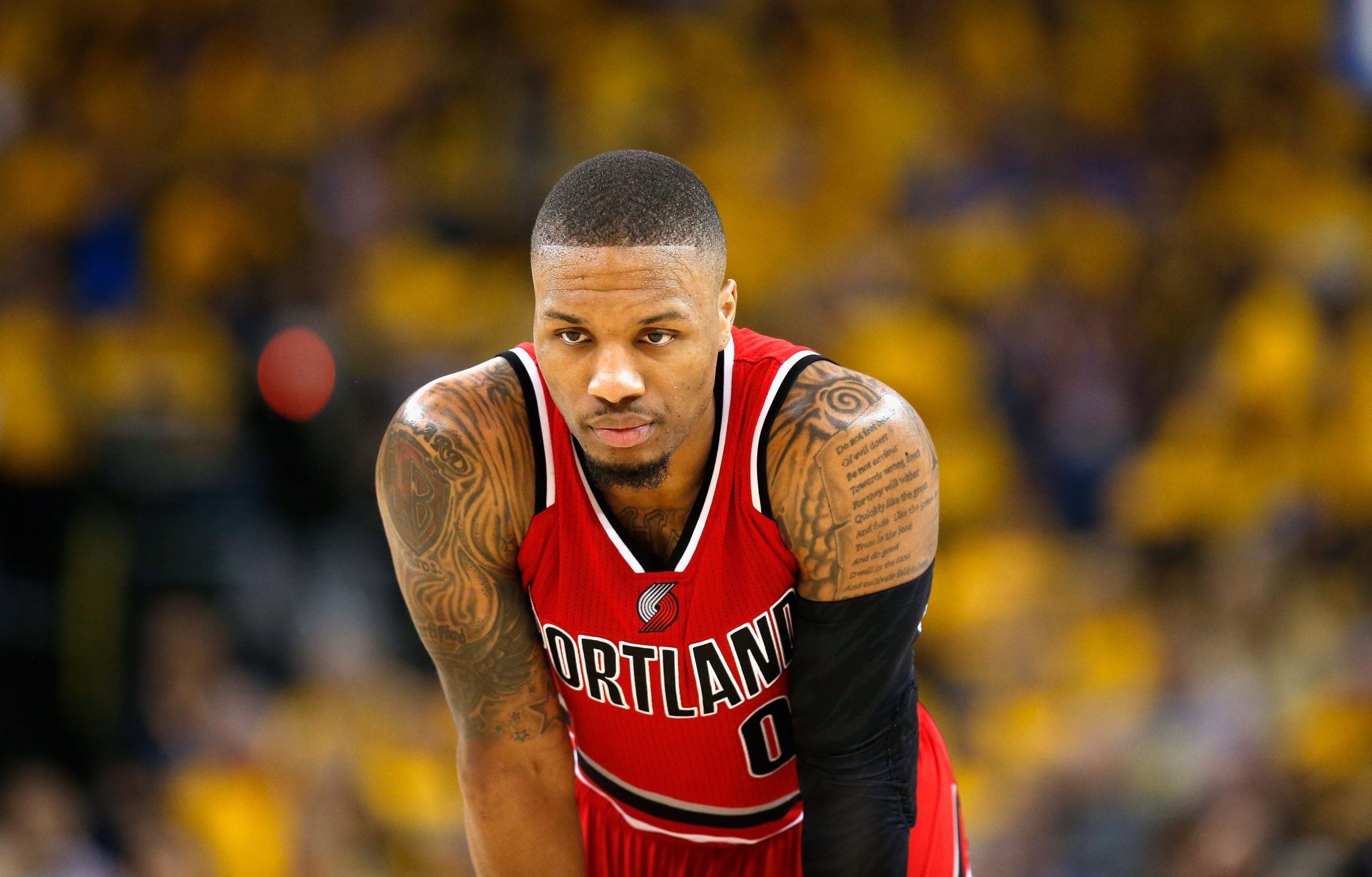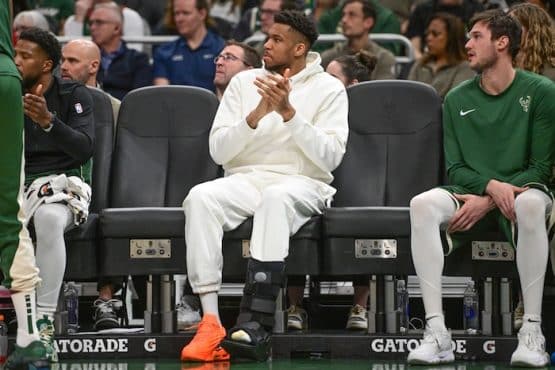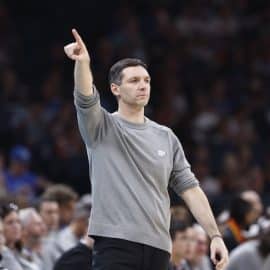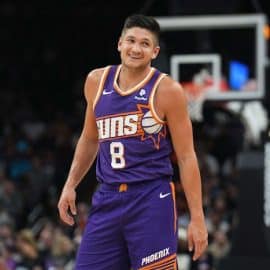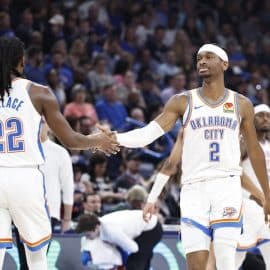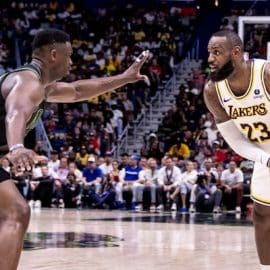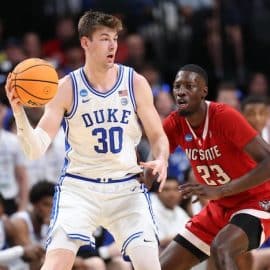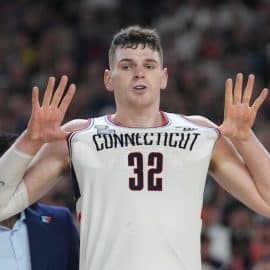The last four regular season records (in no particular order) for the Portland Trail Blazers: 54-28, 51-31, 44-38, 41-41. Not too shabby, right? I was being slightly disingenuous though. Those records are a time series and the trend isn’t pretty. This begs the very pertinent question coming off their first round series sweep at the hands of the Golden State Warriors: where are the Blazers heading?
Neil Olshey was aggressive last offseason, signing Evan Turner and Festus Ezeli while handing out handsome extensions to Maurice Harkless, Meyers Leonard, and Allen Crabbe. Needless to say, star player CJ McCollum earned himself a max contract as well. This leaves the Blazers paying Lillard and McCollum $50M for their services next season, and the rest of the roster another $90M. That’s more than $141M total. Paul Allen may not have an issue paying the luxury tax, but from a management perspective the cap situation limits Olshey’s free agency opportunities to simply the Mid-Level and Low-Level exceptions. So we can write off any established star players ending up in Portland any time soon. Improving the roster will require a focus on the draft with three first round picks – and finding potential trade partners with cap space.
As currently constructed, the Blazers roster composition is heavily reliant on the offense of their superstar guard duo – with gaps to fill all over the place. Backup PG, shooting along the wings, and post defense are Olshey’s three greatest holes to address immediately. Hoodwinking the Nuggets ahead of the deadline was probably the brightest move for the franchise over the last 12 months. Acquiring Jusuf Nurkic and a first round pick for Mason Plumlee looks like even more of a no-brainer now seeing how strongly the team finished the regular season with a healthy Nurkic. Beyond providing scoring and rebounding during his motivated hot stretch in March, Nurkic allows Lillard and McCollum easier offensive opportunities by simply being another option. One month is a small sample size, but considering the promising asset that Nurkic can be, the core that Olshey will probably focus building around will be Lillard, McCollum, Aminu, and Harkless. That leaves Crabbe($18.5M), Turner($17M), Leonard($10M), and Ed Davis($6M) as contracts on the block. If they want to trade these players and expect an upgrade instead of a straight salary dump, they will probably need to give up some combination of their picks and one of Aminu/Harkless. Therein lies the dilemma – how does Portland upgrade its roster while shedding salary without sacrificing too many assets?
Before addressing that, Olshey will have to face the fundamental question of whether blowing things up is an alternative he wants to consider. Most GM’s are risk-averse because owners can be fickle with a desire for immediate progress and results (and concessions from playoff games). It won’t be easy to part with one of his two professional bucket-getters in the backcourt unless there is a sure-fire star wing or big available. Exploring a CJ McCollum for Blake Griffin sign-and-trade might be wise. What if Gordon Hayward shows interest in playing with Lillard? They missed the boat on Nerlens Noel (if they ever had interest to begin with), but would buying extremely low on Jahlil Okafor make sense with Nurkic already on the roster? Perhaps not. No-brainer solutions rarely come around, so the expectation will be that the Blazers will bank on the small sample size of high-quality basketball with Nurkic in the fold, and focus on upgrading the roster around the current core. Standing pat and being patient might be fools gold though given the large sample size of below .500 ball for most of this past season.
The easiest weakness to address this offseason should be the backup PG position. Shabazz Napier simply isn’t going to cut it, unless the expectation is for both Lillard and McCollum to play 82 games of 36+ minutes per game. Evan Turner was one solution that Terry Stotts tried to no avail as the resulting bench units lacked any shooting aside from Allen Crabbe. No need to overspend, but the key is to find a capable backup ball-handler that can keep the defense humble with his shooting ability. First off, it will be interesting to see if one of the highly-touted PG prospects in the draft drops to their 15th pick. I doubt Dennis Smith or Frank Ntilikina drops that far, so bargain hunting will be required unless they are sold on Luke Kennard, Josh Hart, or Jawun Evans being able to contribute immediately. Patty Mills might be available if he prices himself out of what the Spurs would be willing to pay to retain him. But his agent may hang up if the Mid-Level exception is below Patty’s expectation. What’s Deron Williams’s price tag? He’s probably too old and a poor fit anyways. Milos Teodosic would be a fantastic playmaker, but he can’t guard a chair. Shaun Livingston and Darren Collison will likely be too expensive as well, while higher quality PG’s like Lowry, Holiday, Teague, and Hill are out of the question. This leaves three players I would be really keen on for the Lower Level Exception: Tyler Ennis, Aaron Brooks, and Ty Lawson, in that order. Tyler is 22 years old, and even though the Lakers were extremely unwatchable for most of the season, he was a surprising bright spot. There is room for development, and he would be the highest upside investment. Aaron Brooks is a professional backup PG that will make the defense pay if unguarded from beyond the arc. Ty Lawson might be the biggest name on the list, but he showed signs of coming back to life this season and would be an exciting option to rotate in and out with the Lillard-McCollum backcourt. Unfortunately, none of these guys will contribute much on defense, but besides CP3, Conley, Lowry, Hill, Beverley, and Holiday there really aren’t many PG’s that can slow down their counterparts.
Perhaps the biggest problem with most lineups is that the majority of the players on the roster had one of two fatal flaws, inability to shoot or defend. This left coach Stotts in the unenviable position of mixing and matching unbalanced lineups that would consistently be exploited on at least one end of the floor. Allowing opposing defenses to focus all their attention to the backcourt while their wings brick 3’s limits their stars efficiency. On the other end of the floor, the same worn out backcourt could be exploited in the pick-and-roll regardless of how hard talented defenders like Harkless and Aminu would play. Allen Crabbe can shoot, but he isn’t a lock-down defender. What Terry Stotts really needs is a well-rounded wing that can shoot effectively without getting exposed on defense. How about Joe Ingles? His defense on JJ Redick was superb in the first round, and during the season he produced shooting behind the arc at a 44 percent. He brings an added dimension of guarding guards and wings on defense while spreading the floor and handling the rock as either a primary or secondary ball-handler. He had 11 assists in Gordon Hayward’s food poisoning game, and averaged six assists per 100 possessions this season. The only problem is after only making $2M this season, his agent will look to reward Ingles handsomely with a nice new contract. Will the mid-level exception cut it? Perhaps not, unless Ingles checks the market and doesn’t see anyone giving him a long-term deal as he approaches age 30. If the market is near $8-10M per year, the Blazers should consider a tasty trade proposal to Jazz GM Dennis Lindsey: sign-and-trade Ingles with a three-year, $30 million deal for Meyers Leonard and two first round picks (Cleveland and Memphis). The contracts would match perfectly. Do it.
Post Defense is where the Blazers need the most help, but also where they have the most available alternatives. Festus Ezeli was signed specifically to contribute in the paint on the defensive end. His health is as big of a question mark as anyone in the league, but they will keep their fingers crossed that he can come back and contribute. Otherwise his deal is only partially guaranteed ($1M). Last summer, the Spurs signed Dewayne Dedmon to a two-year $6M deal with a player option. I point that out for two reasons; if he opts out, give him a call. If he doesn’t, scour the league for any other big man with a similar skill-set that other GM’s are undervaluing. Astute management requires constantly finding the market inefficiencies ahead of your competitors and the Spurs have filled out their deep rotations with these kind of players for almost two decades. Some alternatives that will be hitting the market this summer include Tiago Splitter, Amir Johnson, Taj Gibson, David West, Javale McGee, and Roy Hibbert. Rank them according to fit, and then see which one is available in the MLE or LLE price range.
Finally, with three first round picks, the scouting department has to put in the hours researching the big men in this draft class. All of them may be available in the 15-26 range where the Blazers will be picking. At 15, the best fit will probably be Zach Collins if he is available. Chances are Collins will not drop out of the lottery, so they will need to be ready to decide between Justin Patton, Isiah Hartenstein, TJ Leaf, Jarrett Allen, Ivan Rabb, Harry Giles, Ike Anigbogu, Bam Adebayo, and Caleb Swanigan. Of those prospects, the five I would really focus on for their potential on the defensive end are: Patton, Allen, Anigbogu, Giles, and Adebayo. Be prepared to draft one or two of them.
So, to summarize:
Sign Tyler Ennis to a 2 year LLE
Trade Meyers Leonard and a first-round pick (or two) for Joe Ingles (Sign-and-Trade, three years, $30M)
Sign Amir Johnson to a 1 year MLE
Draft Jarrett Allen and/or Bam Adebayo
Cut Connaughton, Napier (and possibly Ezeli)
2017-2018 Portland Trail Blazers Rotation
PG: Lillard/Ennis/Brooks
SG: McCollum/Crabbe/Turner
SF: Harkless/Ingles/Layman
PF: Aminu/Davis/Adebayo
C: Nurkic/Johnson/Allen
Add The Sports Daily to your Google News Feed!
